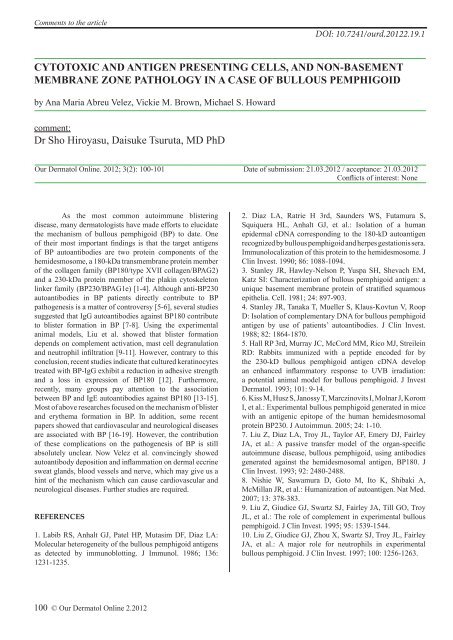download full issue - Our Dermatology Online Journal
download full issue - Our Dermatology Online Journal
download full issue - Our Dermatology Online Journal
You also want an ePaper? Increase the reach of your titles
YUMPU automatically turns print PDFs into web optimized ePapers that Google loves.
Comments to the article<br />
DOI: 10.7241/ourd.20122.19.1<br />
CYTOTOXIC AND ANTIGEN PRESENTING CELLS, AND NON-BASEMENT<br />
MEMBRANE ZONE PATHOLOGY IN A CASE OF BULLOUS PEMPHIGOID<br />
by Ana Maria Abreu Velez, Vickie M. Brown, Michael S. Howard<br />
comment:<br />
Dr Sho Hiroyasu, Daisuke Tsuruta, MD PhD<br />
<strong>Our</strong> Dermatol <strong>Online</strong>. 2012; 3(2): 100-101 Date of submission: 21.03.2012 / acceptance: 21.03.2012<br />
Conflicts of interest: None<br />
As the most common autoimmune blistering<br />
disease, many dermatologists have made efforts to elucidate<br />
the mechanism of bullous pemphigoid (BP) to date. One<br />
of their most important findings is that the target antigens<br />
of BP autoantibodies are two protein components of the<br />
hemidesmosome, a 180-kDa transmembrane protein member<br />
of the collagen family (BP180/type XVII collagen/BPAG2)<br />
and a 230-kDa protein member of the plakin cytoskeleton<br />
linker family (BP230/BPAG1e) [1-4]. Although anti-BP230<br />
autoantibodies in BP patients directly contribute to BP<br />
pathogenesis is a matter of controversy [5-6], several studies<br />
suggested that IgG autoantibodies against BP180 contribute<br />
to blister formation in BP [7-8]. Using the experimental<br />
animal models, Liu et al. showed that blister formation<br />
depends on complement activation, mast cell degranulation<br />
and neutrophil infiltration [9-11]. However, contrary to this<br />
conclusion, recent studies indicate that cultured keratinocytes<br />
treated with BP-IgG exhibit a reduction in adhesive strength<br />
and a loss in expression of BP180 [12]. Furthermore,<br />
recently, many groups pay attention to the association<br />
between BP and IgE autoantibodies against BP180 [13-15].<br />
Most of above researches focused on the mechanism of blister<br />
and erythema formation in BP. In addition, some recent<br />
papers showed that cardiovascular and neurological diseases<br />
are associated with BP [16-19]. However, the contribution<br />
of these complications on the pathogenesis of BP is still<br />
absolutely unclear. Now Velez et al. convincingly showed<br />
autoantibody deposition and inflammation on dermal eccrine<br />
sweat glands, blood vessels and nerve, which may give us a<br />
hint of the mechanism which can cause cardiovascular and<br />
neurological diseases. Further studies are required.<br />
REFERENCES<br />
1. Labib RS, Anhalt GJ, Patel HP, Mutasim DF, Diaz LA:<br />
Molecular heterogeneity of the bullous pemphigoid antigens<br />
as detected by immunoblotting. J Immunol. 1986; 136:<br />
1231-1235.<br />
2. Diaz LA, Ratrie H 3rd, Saunders WS, Futamura S,<br />
Squiquera HL, Anhalt GJ, et al.: Isolation of a human<br />
epidermal cDNA corresponding to the 180-kD autoantigen<br />
recognized by bullous pemphigoid and herpes gestationis sera.<br />
Immunolocalization of this protein to the hemidesmosome. J<br />
Clin Invest. 1990; 86: 1088-1094.<br />
3. Stanley JR, Hawley-Nelson P, Yuspa SH, Shevach EM,<br />
Katz SI: Characterization of bullous pemphigoid antigen: a<br />
unique basement membrane protein of stratified squamous<br />
epithelia. Cell. 1981; 24: 897-903.<br />
4. Stanley JR, Tanaka T, Mueller S, Klaus-Kovtun V, Roop<br />
D: Isolation of complementary DNA for bullous pemphigoid<br />
antigen by use of patients’ autoantibodies. J Clin Invest.<br />
1988; 82: 1864-1870.<br />
5. Hall RP 3rd, Murray JC, McCord MM, Rico MJ, Streilein<br />
RD: Rabbits immunized with a peptide encoded for by<br />
the 230-kD bullous pemphigoid antigen cDNA develop<br />
an enhanced inflammatory response to UVB irradiation:<br />
a potential animal model for bullous pemphigoid. J Invest<br />
Dermatol. 1993; 101: 9-14.<br />
6. Kiss M, Husz S, Janossy T, Marczinovits I, Molnar J, Korom<br />
I, et al.: Experimental bullous pemphigoid generated in mice<br />
with an antigenic epitope of the human hemidesmosomal<br />
protein BP230. J Autoimmun. 2005; 24: 1-10.<br />
7. Liu Z, Diaz LA, Troy JL, Taylor AF, Emery DJ, Fairley<br />
JA, et al.: A passive transfer model of the organ-specific<br />
autoimmune disease, bullous pemphigoid, using antibodies<br />
generated against the hemidesmosomal antigen, BP180. J<br />
Clin Invest. 1993; 92: 2480-2488.<br />
8. Nishie W, Sawamura D, Goto M, Ito K, Shibaki A,<br />
McMillan JR, et al.: Humanization of autoantigen. Nat Med.<br />
2007; 13: 378-383.<br />
9. Liu Z, Giudice GJ, Swartz SJ, Fairley JA, Till GO, Troy<br />
JL, et al.: The role of complement in experimental bullous<br />
pemphigoid. J Clin Invest. 1995; 95: 1539-1544.<br />
10. Liu Z, Giudice GJ, Zhou X, Swartz SJ, Troy JL, Fairley<br />
JA, et al.: A major role for neutrophils in experimental<br />
bullous pemphigoid. J Clin Invest. 1997; 100: 1256-1263.<br />
100 © <strong>Our</strong> Dermatol <strong>Online</strong> 2.2012















